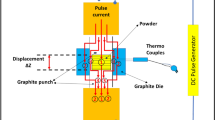The results of investigations of the structure and properties of conventional ceramic stone bodies, including leaners, fluxes, and clay materials (36, 14, and 50% by weight, respectively) in the initial composition, on systematic variations of the ratios kaolinite- and illite-containing clays and firing temperatures/times in the temperature range 1000 – 1300°C are presented. The optimal ratios of kaolinite and illitic clays and the sintering conditions under which the ceramic properties of the material materialize are determined by means of investigations of the structure and phase composition as well as the dilatometric and ceramic properties. It is shown that the maximum compaction of ceramic (open porosity/water absorption 2 – 5%, apparent density ≥2 g/cm3) is achieved in the sinter state range 1150 – 1250°C and is realized when the equivalent weight ratios of both clays is kept close to 1 : 1 in the initial makeups.





Similar content being viewed by others
References
C. B. Carter and M. G. Norton, Ceramic Materials: Science and Engineering, Springer-Verlag, New-York (2007), pp. 353 – 360.
Ch. Woodford, Ceramics, Springer Science & Business Media, New York (2020). Google Books. https://doi.org/10.1007/978-0-387-46271-4.
S. J. Schneider (volume chairman), Ceramic and Glasses, Engineered Materials Handbook, Vol. 4, ASM, The Materials Information Society CRC Press (1991), pp. 3 – 9.
W. D. Nesse, Introduction to Mineralogy, Oxford University Press, NY (2000), pp. 235 – 257.
B. Lee and S. Komarneni (eds.), Chemical Processing of Ceramics, CRC Press, Boca Raton (2005), pp. 370 – 375.
Clays and Clay Minerals, CMLM 2009: International Conference on Clay, Clay Minerals, and Layered Materials, September 21 – 25, 2009, Abstracts, I. V. Balabanov Publisher, Moscow (2009), pp. 14 – 70.
Sibelco. URL: http://ceramicbodies.sibelco.eu/en/productfinder/all. (1.11.2019)
I. D. Borneman-Starynkevich (ed.), Methods of Chemical Analysis and Composition of Minerals [in Russian], Nauka, Moscow (1971).
P. J. Potts, A Handbook of Silicate Rock Analysis: Classical and Rapid Methods of Analysis, Springer Science and Business Media, New-York (1992), pp. 77 – 105.
Author information
Authors and Affiliations
Corresponding author
Additional information
Translated from Steklo i Keramika, No. 7, pp. 40 – 45, July, 2021.
Rights and permissions
About this article
Cite this article
Sedmale, G.P., Pokshans, I.A., Randers, M.A. et al. Influence of Illitic Clays on the Sintering, Properties, and Structure of Ceramic Stone Materials. Glass Ceram 78, 288–292 (2021). https://doi.org/10.1007/s10717-021-00397-7
Published:
Issue Date:
DOI: https://doi.org/10.1007/s10717-021-00397-7




